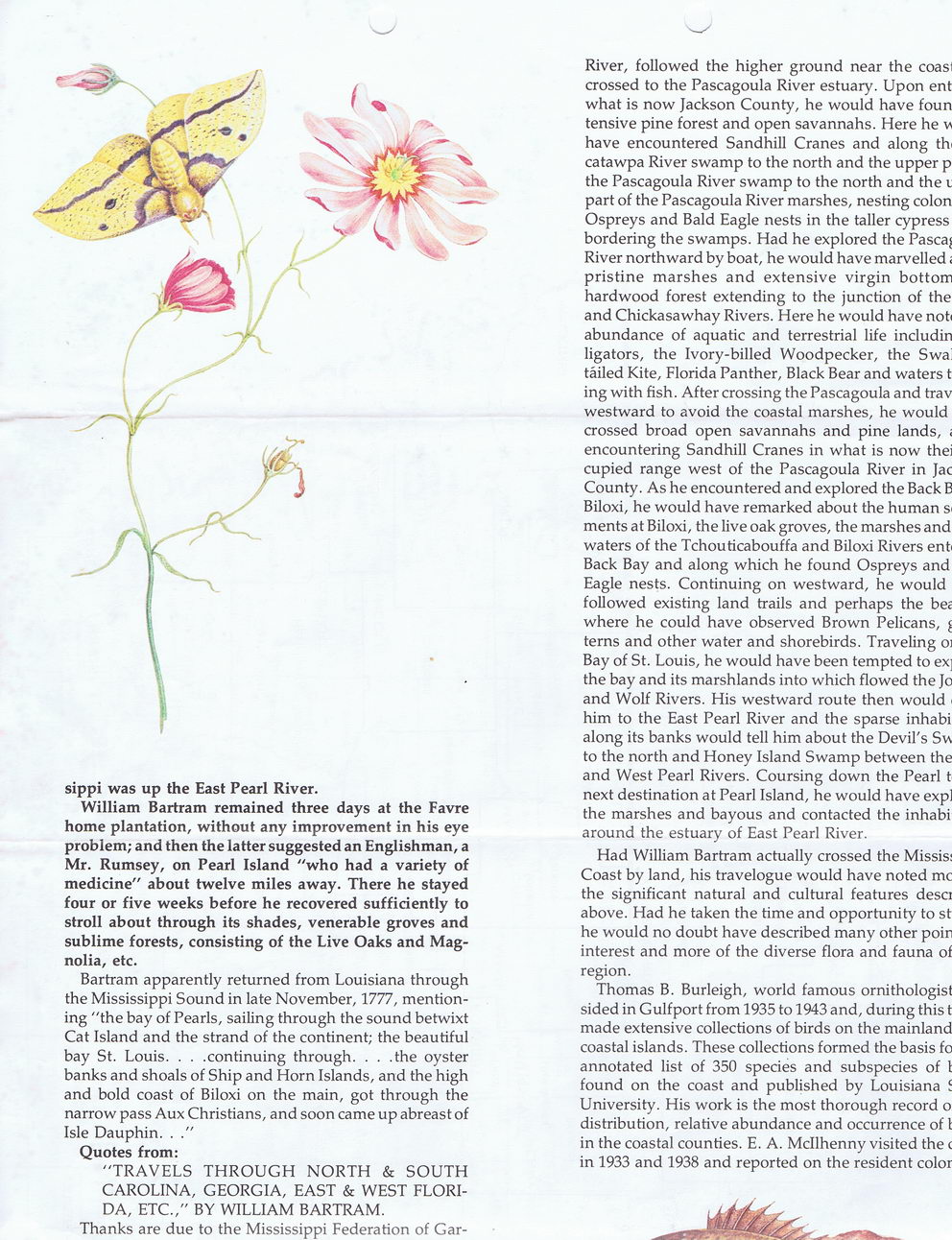This text was obtained via automated optical character recognition.
It has not been edited and may therefore contain several errors.
sippi was up the East Pearl River. William Bartram remained three days at the Favre home plantation, without any improvement in his eye problem; and then the latter suggested an Englishman, a Mr. Rumsey, on Pearl Island "who had a variety of medicine" about twelve miles away. There he stayed four or five weeks before he recovered sufficiently to stroll about through its shades, venerable groves and sublime forests, consisting of the Live Oaks and Magnolia, etc. Bartram apparently returned from Louisiana through the Mississippi Sound in late November, 1777, mentioning "the bay of Pearls, sailing through the sound betwixt Cat Island and the strand of the continent; the beautiful bay St. Louis. . . .continuing through. . . .the oyster banks and shoals of Ship and Horn Islands, and the high and bold coast of Biloxi on the main, got through the narrow pass Aux Christians, and soon came up abreast of Isle Dauphin. . ." Quotes from: "TRAVELS THROUGH NORTH & SOUTH CAROLINA, GEORGIA, EAST & WEST FLORIDA, ETC.," BY WILLIAM BARTRAM. Thanks are due to the Mississippi Federation of Gar- River, followed the higher ground near the coasl crossed to the Pascagoula River estuary. Upon ent what is now Jackson County, he would have foun tensive pine forest and open savannahs. Here he v\ have encountered Sandhill Cranes and along thi catawpa River swamp to the north and the upper p the Pascagoula River swamp to the north and the i: part of the Pascagoula River marshes, nesting colon Ospreys and Bald Eagle nests in the taller cypress bordering the swamps. Had he explored the Pascaj River northward by boat, he would have marvelled; pristine marshes and extensive virgin bottom hardwood forest extending to the junction of the and Chickasawhay Rivers. Here he would have noti abundance of aquatic and terrestrial life includin ligators, the Ivory-billed Woodpecker, the Swai tailed Kite, Florida Panther, Black Bear and waters t ing with fish. After crossing the Pascagoula and trav westward to avoid the coastal marshes, he would crossed broad open savannahs and pine lands, ; encountering Sandhill Cranes in what is now thei cupied range west of the Pascagoula River in Jac County. As he encountered and explored the Back B Biloxi, he would have remarked about the human si ments at Biloxi, the live oak groves, the marshes and waters of the Tchouticabouffa and Biloxi Rivers enti Back Bay and along which he found Ospreys and Eagle nests. Continuing on westward, he would followed existing land trails and perhaps the bee where he could have observed Brown Pelicans, ? terns and other water and shorebirds. Traveling oi Bay of St. Louis, he would have been tempted to exj the bay and its marshlands into which flowed the Jo and Wolf Rivers. His westward route then would < him to the East Pearl River and the sparse inhabi along its banks would tell him about the Devil's Sw to the north and Honey Island Swamp between the and West Pearl Rivers. Coursing down the Pearl t next destination at Pearl Island, he would have exp] the marshes and bayous and contacted the inhabi around the estuary of East Pearl River. Had William Bartram actually crossed the Missis; Coast by land, his travelogue would have noted me the significant natural and cultural features desci above. Had he taken the time and opportunity to st he would no doubt have described many other poin interest and more of the diverse flora and fauna of region. Thomas B. Burleigh, world famous ornithologist sided in Gulfport from 1935 to 1943 and, during this t made extensive collections of birds on the mainland coastal islands. These collections formed the basis fo annotated list of 350 species and subspecies of 1 found on the coast and published by Louisiana J University. His work is the most thorough record o distribution, relative abundance and occurrence of t in the coastal counties. E. A. Mcllhenny visited the c in 1933 and 1938 and reported on the resident color

Bartram The-National-Bartram-Historical-Trail-of-Mississippi-Pg.9